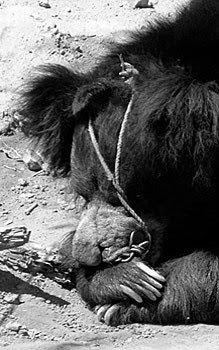Sunday, October 31, 2010
Snails
Thursday, October 21, 2010
Cambodia's Legend

Today, children in at least 68 countries are
still threatened by mines in their country.
Every 30 minutes, someone in the world is injured or killed by landmines and unexploded bombs. At least one in every four victims is a child.
Each land mine may remain active for up to 50 years. 50 years!
Thirty years of war in Cambodia has resulted in a landmine count of 8 – 10 million, rating Cambodia 6th in the Most Mined Countries List.
Since 1979, about 40,000 Cambodians have required amputations.
That represents nearly forty victims a week for twenty years. Cambodia has the highest amputation rates per capita in the world. About one in 275 people have lost a limb. I can’t help but wonder how many others from remote and rural areas could be added to these numbers.
Stepping on a landmine has tragic effects on children. Children’s bones grow faster than the nearby tissue. As a result, they may require repeated amputation and a new artificial limb every six months. In Cambodia, this may not be available.
A survey found that 70 % of all casualties were in the northwest, with half in just 20 districts. (This is along the Thai – Cambodian border.)
Mining farming land has also led to malnutrition,
even to famine and starvation.
Land cannot be farmed due to the mines hidden beneath the surface.
Livestock lost to mines can devastate a family.
Clearing a field of mines gives life
back to a community and restores dignity.
People can finally grow their own crops.
Officially, mine removal is a lengthy and expensive business.
Weapons that cost $3 to make can cost up to $1,000 to remove.
Over 1,000 landmines can be spread in a minute.
Skilled experts may spend an entire day clearing
20-50 square metres of mine-contaminated land.
In one seven month project, 45 workers found 265 mines and 943 units of unexploded ordinance. The cost of the project was about $US378,000 or about $US1,400 a mine.
At this rate, it may take 100 years to clear all the mines in Cambodia.
So, what of that man who has remained in my memory...
The one who caused me to change my course of thought...
This is what he does:
"I poke my stick in the ground till I find a mine.
Then I dig around it, to make sure that it is not booby-trapped.
Then, I unscrew the detonator. And the mine is safe."
His name is Aki Ra.
By the age of five, his parents had been killed and he was conscripted as a soldier with the Khmer Rouge. He learned jungle fighting tactics and was used to plant mines along the Thai – Cambodian border. He did this for a decade, until the Vietnamese took control of the country. For another decade he worked, just for a different side, this time. Next, he returned and joined the Cambodian Military.
His life changed direction when the UN stepped in and trained locals on the safe removal of landmines. He was shown how to use body armour, mine detectors and sweep and clear removal processes. The only problem... when the UN left, there was no more money. Aki Ra could no longer afford the specialised equipment. With no equipment, he began using a shovel to dig up grenades and force sticks into them until they were safe to handle.
While it takes two hours for the UN to defuse a landmine, Aki Ra can do it in two minutes.
He uses shovels, sticks and pocket knives to clear Cambodia of mines. He almost single-handedly cleared out the mines surrounding the Temples at Angkor Wat. After this, he cleared playgrounds and farmlands that had not been accessible for decades. As a result, the number of landmine casualties dropped from 3,047 to 1,109 between 1996 and 1999.
In 1998 he opened the Cambodian Landmine Museum.
Now, he is training villagers and Cambodian Army soldiers in his method of digging up and disarming mines. Over 1,000 of his people are now working
in de-mining operations across the country.
Aki Ra believes that he has removed and cleared over
50,000 mines in 16 years using his method.
Children who have suffered due to amputations are also cared for by Aki Ra. Homeless and troubled children are cared for and fed by him.
Aki Ra says: "There are still over one million landmines in Cambodia. At the rate they are going now, it will take 50-100 years to finish. If they give me a license then I could teach villagers to de-mine the way I do. It is fast, easy, and cheap. I believe we could have the whole country de-mined in 3-5 years."
As I wondered around the Angkor temples, I felt safe in the knowledge that the area was clean of mines.
For that, I need to thank Aki Ra.
What an amazing man.
Sunday, October 17, 2010
Aroy!
Colours of Spring
Friday, October 1, 2010
Dancing Bears

An Indian bear, dancing on the side of the road,
trucks tearing along beside it.
I was young and didn’t really understand.
Now, I’m a little older.
I know about the ropes, now.
I know that the ropes
are twisted through the nostrils of the bear.
I know that the Indian man pulls on the rope…
making the bear stand up against the searing pain.
The bear’s not dancing… it just looks like it is.

I’m not alone in disliking the idea of dancing bears. Several groups have formed to reduce the numbers of bears being forced to dance for a living.
In 1998, bear dancing was banned by the government.
Many of the men who owned the bears are learning new skills. Many are developing new businesses. Some learn to make soap or incense sticks.
These men are handing back the bears.
Bears which are handed in, are provided with
a nutritious diet and veterinary care.

In about 5 years, approximately 250 bears have stopped dancing.
The locals are learning to value the bears and have started
reporting bear poachers.
I saw a photo once. It was ugly, but the bear was free…
The photo made me smile.
















